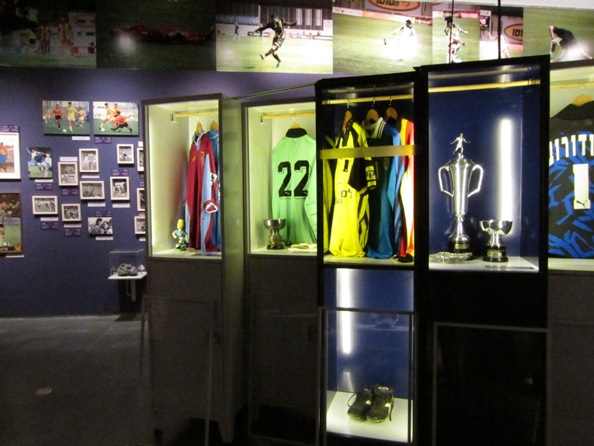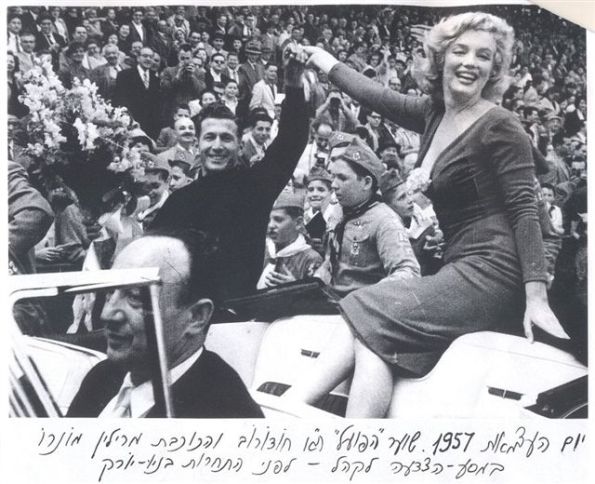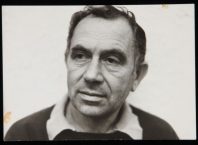
Football. 22 grown men who ought to know better running after a ball. Or a rich cultural and sociological repository. You take your pick.
Actually, its a bit of both. There’s no disputing football’s relevance as perhaps the cultural signifier of our age. It’s the lingua franca that obtains from London to Lima, Johannesburg to Jerusalem, and pretty much everywhere in between. There is the argument that this merely panders to the lowest common denominator. But I’m not so sure. One would be hard put to find any single pursuit that can evoke such extremes of passion, commitment, camaraderie; one would be hard put to find an activity that does all this, and that at the same time can tell the story of a nation. It’s all there, if you know where to look for it…
We Have A Champion! A Hundred Years of Football in Israel is a surprise in that – like most football fans – it is fiercely partisan, yet does enough to invite even those with less than a passing interest in the beautiful game. As the name suggests, it is an overview of a century of the game in Israel. But for once, this curated exhibit is somewhat modest in setting out its stall. It is about football: it is also about politics, and history, and life. Of course, football fans argue that it has always been thus. Now here’s an opportunity for unbelievers to be convinced.
Football was introduced into Palestine a century ago, although no one is sure whether this was by the Turkish overlords or Russian immigrants who came in the second Aliyah. Either way, what is known – and is shown, through archive photographs and the like – is that even at the beginning, it played an important part in the national psyche. Sports were an integral part of the re-shaping of Jewish identity in the new land, part of casting away the stereotypical weakness of the Galut Jew and establishing the image of the hewer and toiler, the builder of the land.
Football was a useful conduit for casting this image of the “muscular Jew”: but this aside, the very organization of the game supported the expression of partisan allegiances witin the community, particularly useful at a time when different streams of ideological thought were competing for supremacy. Dana Heller’s thoughtful curation allows one to fix – to interpret, even – significant socio-political events against the development of the sport in Palestine. Who knew that the rivalry between the Hapoel and Maccabi sports associations (the shenanigans between Hapoel TA and Maccabi TA a couple of weeks ago being the most recent example) has its roots in Hapoel’s allegience to the international labour movement and Maccabi’s non-partisan (and bourgeoise, to boot) Zionist affiliations?

Sepia-tinted photographs set the mood for this most unexpected of history lessons, taking in intra-national rivalries, geo-political tensions and national pride. With the last, there is a counter-intuitive photograph of Marilyn Monroe meeting the Israeli national team at Ebbets Field, NY, during a state-side tour in 1957. As the story goes, the team were asked whom they’d like to meet during their visit. “As athletes, we’d like to meet the Brooklyn Dodgers; as men, we’d like to meet Marilyn Monroe,” was the fabled response.
Orwell once described organized sport as war minus the shooting. An exaggeration of course, but not by very much. The rituals of the game are not far removed from the rituals of combat; the livery, the songs and chants intended to rouse the martial spirit, the utter and complete contempt for the enemy. All are captured to remarkable effect in “Sivan” a short film by Zohar Elefant. The film tracks the eponymous heroine across the course of a game; the range of emotion exhibited over 90 minutes an astonishing reminder of the capacity the game retains for evoking extremes of passion.
The other end of such devotion is the garish tat that football fans seem particularly partial towards. Scarfs, hats and alarm clocks in the colors of ones favorite team are all very well. But as for some of the other stuff – a Maccabi Haifa kettle, a head mounted umbrella in the colors of Beitar Jerusalem? Perhaps football fans do have sense of humor after all.
Interspersed amongst the history and culture are other interesting signifiers – a painting by Rueven Rubin, a collection of songs from that fascinating genre, fan songs (“A Samba for Maccabi Haifa”, anyone?) and, at the end of the circuit, a compilation of the greatest moments in Israeli football.
My favourite was missing sadly, Reuven Atar’s 93rd minute winner against France in 1993. Admittedly, nothing was at stake in the game – the Blue and White already out of contention for the 1994 World Cup. But the moment of transcendent ecstasy in the commentator’s voice…football means much more to many people than one can ever know, I suspect.





